
If you’re in the bustling hospitality industry, you know the challenge well: How do you spread the word about your fabulous hotel, outstanding restaurant, or adrenaline-pumping adventure service? There’s social media, of course, with its over four billion users who are likely to include your target audience. There are other effective digital marketing channels, too, like SEO. But social media and search engine algorithms change. That increased visibility you might enjoy one time can be easily gone in an instant. The good news is there’s a tool that offers consistent marketing results as long as you follow a good strategy. Say hello to email marketing for hospitality.
Why is Email Marketing Important in the Hospitality Industry?
Email marketing for hospitality is like a direct line to your customers’ hearts and inboxes. The numbers don’t lie. Email marketing ROI is a staggering 4400%.
You see, if your customer is willingly giving you their email address, it’s because they’re interested in what you offer. They’ve taken that step further than just scrolling past your post on Instagram or Facebook. With email, you have their attention, and that’s a golden opportunity.
That’s not to say you should rely solely on email marketing. Leverage other marketing strategies, too. Promote your brand using your social media channels for excellent engagement, boost your SEO for enhanced online visibility. Then, you can reap the best results.
Now, let’s delve deeper into the diverse sectors of the hospitality industry, each with its unique flavor and challenges, and see how email marketing efforts can turn challenges into triumphs.
Analyzing the Hospitality Industry
The hospitality industry isn’t a one-size-fits-all domain. It encompasses hotels, restaurants, travel services, and event spaces. Each subset has its unique charm and target audience. Now check out how email marketing can help each sector.
1. Hotels and Resorts
The hotel industry means more than just places to rest. Hotels are gateways to experiences. When it comes to email marketing for the hospitality industry, hotels and resorts can send their subscribers personalized offers, local guides, and upcoming event details. The aim is to keep your establishment on people’s minds.
Let’s say you run a luxurious beachside resort. Your potential guests might visit your website, but what if they leave without making a reservation? This is where hotel email marketing steps in.

By capturing people’s email addresses, you can send personalized follow-up emails. Share breathtaking images of your rooms overlooking the ocean and offer a special discount if they book within a certain timeframe. With this strategy, you’re not just sending emails. You’re planting the seeds of anticipation and making them want to experience what you’re saying for themselves.
2. Restaurants and Bars
For restaurant and bar owners, as a part of their restaurant marketing strategy, email marketing is more than just a promotional tool–it’s a way to cultivate experiences and make memories. Think about your favorite local eatery. You’ve had that perfect meal there, and now you’re on their email list. Suddenly, your inbox becomes a treasure trove of culinary wonders.
So, if you are the owner of a cozy bistro you can use email communication to transport your subscribers into the heart of your kitchen. Share behind-the-scenes stories of your chefs sourcing ingredients from local farms, crafting new recipes, and experimenting with flavors.
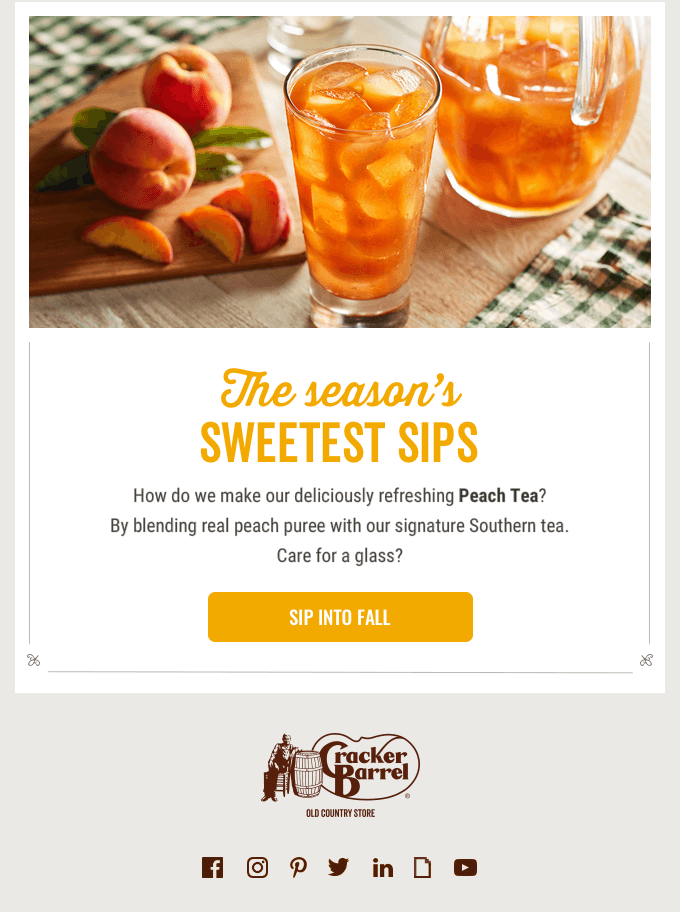
When you introduce a new seasonal menu, send an email that takes your subscribers on a gastronomic journey. Share the inspiration behind each dish, complete with tantalizing images that make taste buds tingle. Don’t forget to include an exclusive offer for your email subscribers.
3. Travel
Now, let’s have a closer look at the tourism and travel industry. Say, you own a travel agency specializing in adventure trips. Your clients dream of breathtaking landscapes and thrilling escapades, and it’s your job to turn those dreams into reality. This is where email marketing can help you.
As a travel business, your emails can whisk subscribers away to exotic destinations even before they’ve packed their bags.
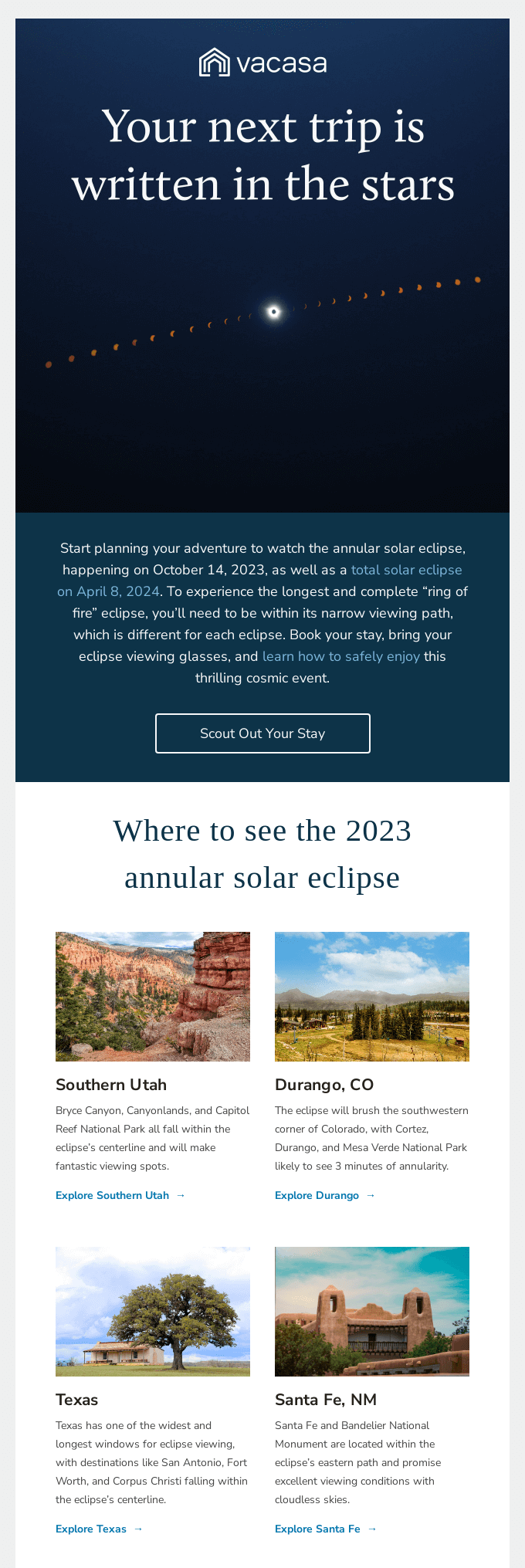
Send curated travel guides to bucket-list most beautiful locations, complete with stunning visuals and insider tips. Share testimonials and stories from previous travelers, highlighting the transformative experiences your agency offers. When you have a limited-time deal, a special event, or an itinerary, email is your megaphone to broadcast these opportunities to your eager audience.
You can send personalized emails (more on this later) featuring destinations similar to places your subscribers have previously shown interest in. By recommending places that align with people’s preferences, you can create an experience that feels tailor-made. You can also send post-trip emails, encouraging users to leave reviews and share their adventures. This not only keeps the experience alive but also fuels anticipation for the next journey.
4. Event and Conference Spaces
For event and conference space owners, success is measured by the seamless experiences you create for hosts and attendees alike. How do you communicate your space’s unique features, amenities, and the extraordinary events held there? Email marketing is your answer.
So, if you manage a flexible event venue, you can showcase your space through stunning images and immersive virtual tours in your emails. Share success stories of previous events, highlighting how your venue transformed into an enchanting wedding wonderland or a cutting-edge conference hub.
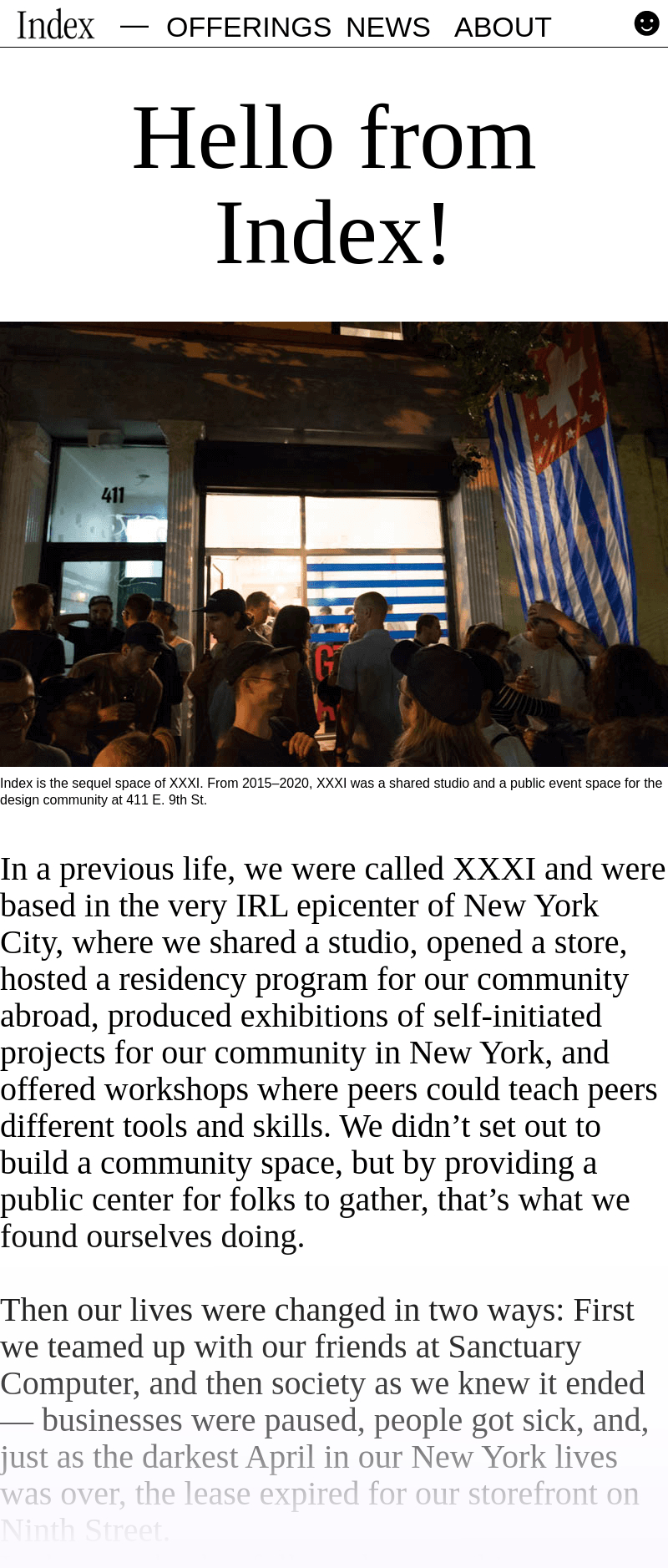
Use email to offer event planning tips, and guides on utilizing your space effectively, and even connect subscribers with vendors who’ve worked their magic within your walls. By offering valuable insights, along with your confirmation emails, you position yourself not just as a space provider, but as a partner in event success.
4 types of Email Campaigns to Consider
So, now that you have an idea of what’s possible, here are different types of emails you might consider sending your potential customers:
Welcome emails. First impressions matter.

Make your subscribers feel at home with a warm welcome and an offer of exclusivity.
Loyalty program emails. Everyone loves rewards.
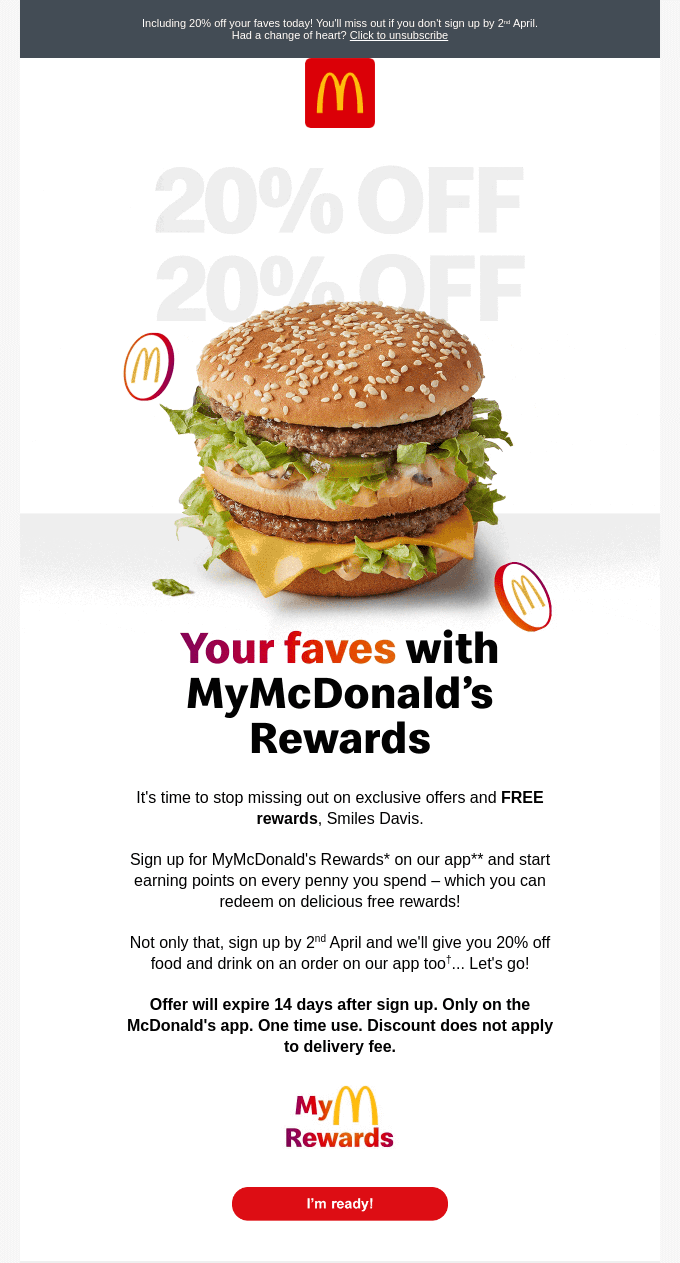
Treat your loyal customers to special offers, early access, and VIP experiences that keep them coming back.
Seasonal promotions. Holidays and special occasions are opportunities you shouldn’t miss.
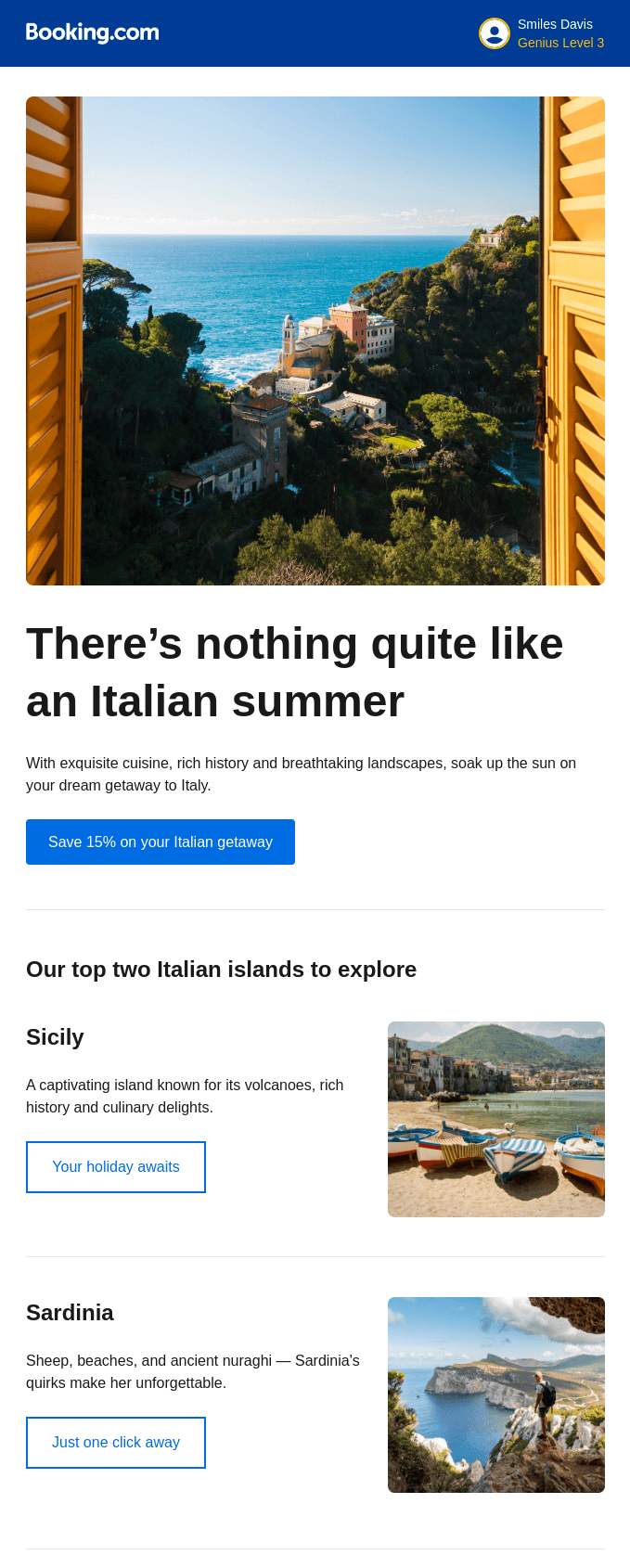
Craft emails that celebrate the season with irresistible offers.
Feedback emails. Your customers’ opinions are gold. Send surveys in your post-stay emails to show that you value guest feedback and use it to enhance their experience.
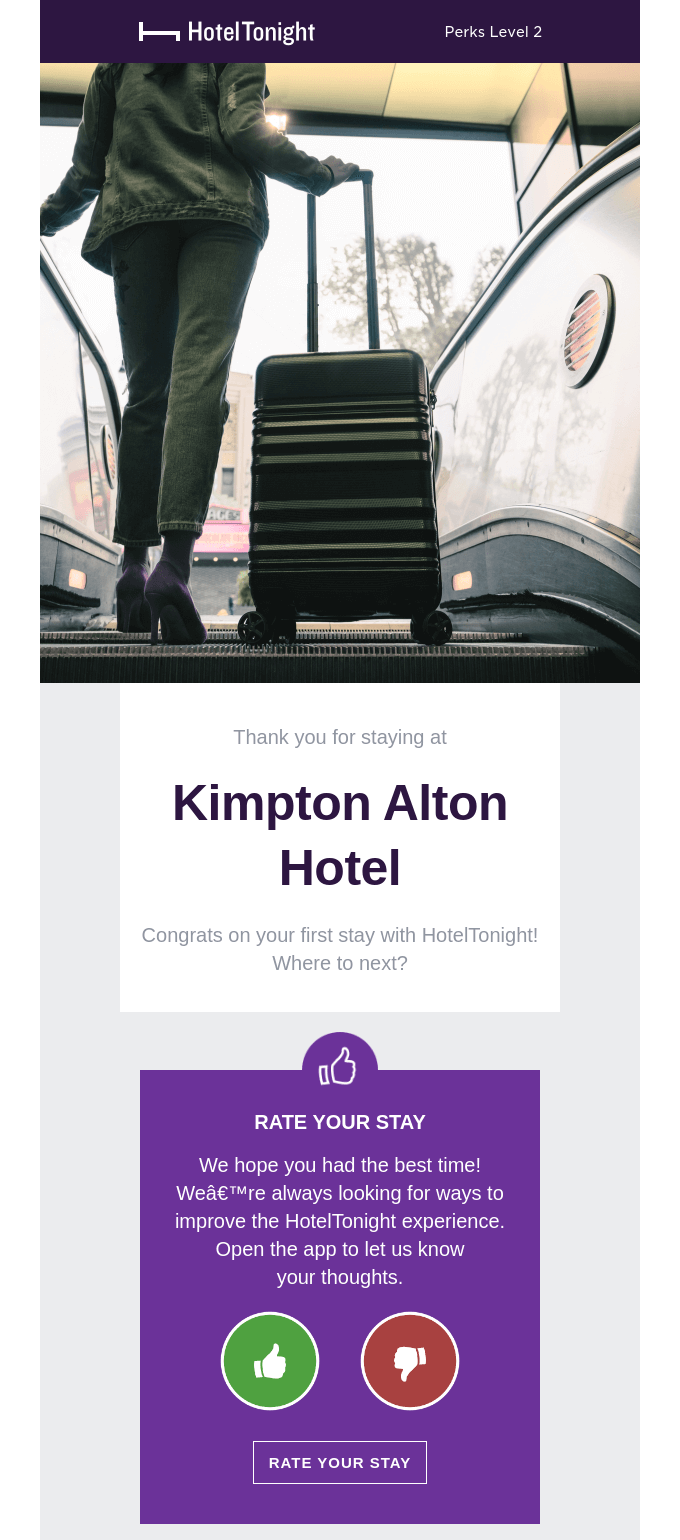
To ensure a robust digital marketing strategy for your hospitality business, you need to include all of these email campaign types in your overarching plan. This multifaceted approach will engage your audience and ensure a consistent and personalized connection that keeps your guests coming back for more.
5 Effective Email Marketing Strategy Tips
Now, let’s get practical. How can you actually ensure your emails are effective? Follow these tips as part of your email marketing strategy:
1. Build Your Email list From Scratch and Grow it
Before you can send your emails, you need an email list. But don’t just buy email lists that can damage your brand reputation. You need to create your own from scratch.
Start with creating irresistible sign-up opportunities at every interaction point with potential customers. Whether it’s your website, social media profiles, or your venue, entice visitors with something valuable in exchange for their email addresses.
This could be a downloadable local guide filled with insider tips, a special discount for their first stay, or a complimentary appetizer at your restaurant. The goal is to make signing up too tempting to pass up.
Ensure a great user experience, too. So, if it’s your website that carries your lead magnet, for instance, make sure it loads quickly. Fast web hosts usually ensure not just good loading speeds but also high uptime. These are things that will make it easy for your target audience to take you up on your offer and subscribe to your email list.
You can also host social media contests and giveaways that require participants to provide their email addresses for entry. Ensure that the prizes align with your hospitality business, such as a free night’s stay, a meal, or a freebie. These kinds of promotions don’t just help grow your email list. They also help you generate enthusiasm and buzz around your brand. You can add Facebook friends and Twitter followers to increase your contest’s reach.
Leverage networking and partnerships with complementary businesses in your area, too. If, for instance, you operate a boutique hotel, collaborate with a local spa or winery. Promote each other’s services and include clear calls to action for email sign-ups. This strategic approach not only helps you grow your email list. It also fosters mutually beneficial relationships.
2. Segment Your Email Database
Not all subscribers are the same. If you send the same generic email to all your subscribers, you’re bound to have some subscribers who don’t like the content. This is why segmentation is important.
Segmentation allows you to send personalized, relevant content that speaks directly to each group’s interests. The result? You increase engagement, open rates, and conversions.
You can divide your subscribers based on the following data points, which you can get through audience research:
- Demographics
- Behavioral Data
- Purchase History
- Email Engagement
There are email marketing tools you can use to segment your email list. With Smaily, for instance, you can easily sort out your contacts imported from MailChimp, Gmail, or Outlook using filters. You can add and remove contacts when necessary, too.
Segmentation might seem like a bit of extra work, but the results speak for themselves. In fact, 78% ranked subscriber segmentation as the most effective strategy for email marketing campaigns.
3. Personalize Your Emails
Don’t just send emails relevant to each of your email segments. As I said earlier, you need to personalize your emails, too. If your emails resonate with each subscriber’s unique preference and behavior, you can easily make a connection with them.
For starters, address your recipients by their first names. Smaily offers easy ways to insert a recipient’s name into the email newsletter. You can choose a variable from the drop-down menu or enclose the variable in double brackets.
You can also analyze your subscribers’ past interactions with your business and send recommendations based on past behavior. For example, If a customer frequently books weekend getaways at your hotel, send them emails featuring similar offers.
If someone starts the booking process but doesn’t complete it, why not send a personalized reminder email? Include details about the items or services left in their cart (see the example below) and encourage them to finish the booking.
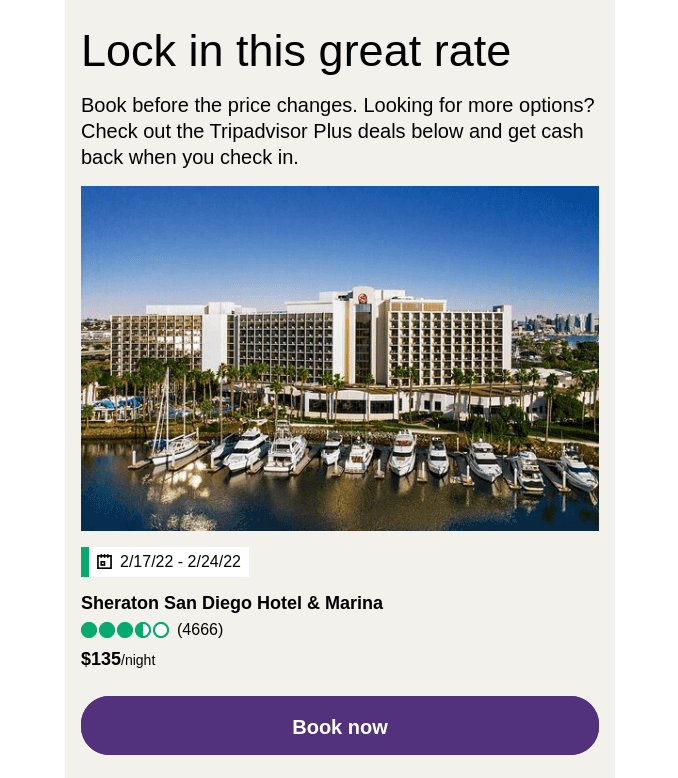
Another effective tactic is email automation to send behavior-triggered emails. Email automation is highly effective in other sectors like SaaS marketing. Along with other strategies like SaaS link building, automated email marketing plays a crucial role in enhancing online visibility.
So, if a customer frequently opens your emails about your vegetarian menu, send them exclusive vegetarian dining offers. This type of personalization shows that you’re paying attention to their preferences.
4. Implement a Strong Email Content Strategy
Effective email content isn’t just about selling. It’s about creating valuable and memorable experiences for your target audience. You need to mix and match content to catch your subscriber’s attention and sustain it throughout your campaign. Just follow the next tips to ensure a strong email content strategy.
-
Balance promotional and non-promotional content
Stick to the 80/20 rule, which says that 80% of your marketing material should be educational and the rest 20% can be promotional. You can leverage AI based prompts to come up with ideas for your content. There are generative AI guides that provide insights and use cases to marketers to craft effective content for their audience.
-
Leverage user-generated content (UGC)
Encourage your customers to share their experiences and use their content in your emails. User-generated content adds authenticity and builds trust. If you’re a restaurant, showcase photos of satisfied diners enjoying their meals. If you’re a travel agency, feature testimonials and stories from travelers who’ve had incredible journeys.
-
Experiment with interactive content
Interactive content boosts engagement and provides valuable data for further personalization. Place quizzes, polls, and surveys in your emails. For instance, if you’re a spa, send out a quiz to help subscribers determine their ideal spa treatment.
-
Tell your story
Storytelling creates an emotional connection and sets you apart from competitors. Craft narratives that resonate with your audience. Share stories about the history of your establishment, the people behind the scenes, your commitment to sustainability, etc.
-
Use a clear Call-to-Action (CTA)
Every email should have a clear purpose, and that purpose should be reflected in a compelling CTA. Whether it’s ‘Book Now,’ ‘Explore Our Menu,’ or ‘Start Your Adventure,’ your CTA should guide potential guests on the next step you want them to take.
-
Show high-quality visuals
Don’t underestimate the power of images. Use amazing images and graphics that align with your brand’s aesthetics. Visuals should complement your content and make your emails visually appealing.
The last tip is to stay consistent, as consistency builds anticipation and trust. Create a consistent email schedule using your content marketing calendar. Whether it’s a weekly email newsletter or monthly promotions, your subscribers should know when to expect your messages.

5. Monitor
Your job doesn’t end with hitting the ‘send’ button. You need to monitor and analyze the progress of your campaigns to determine what works and what doesn’t. If something doesn’t work, you can make fixes.
Start by studying analytics provided by your email service provider. Pay close attention to, among other things:
- open rates
- click-through rates
- conversion rates
- unsubscribe rates.
These metrics provide a snapshot of how engaging and effective your emails are.
You also need to track conversions. This involves monitoring the actions you want your recipients to take after reading your emails. For hotels, it could be tracking how many subscribers who received a promotional email went on to make a reservation. In the restaurant business, it might involve monitoring how many subscribers booked a table after receiving an email about your special dining experience.
Use A/B testing to refine your content strategy, too. Test and analyze elements like your content formats and CTAs to see what resonates best with your audience. With Smaily, apart from these, you can easily test your subject line and even your design.
Finally, keep an eye on your email list’s growth. Are you regularly getting new subscribers, or are many leaving? If your list isn’t growing well, maybe you should look at your sign-up rewards or the content you’re sharing.
In Closing
Email marketing for hospitality can prove to be a powerful tool for your business. You now know the dos and don’ts for the best marketing results.
Make people excited to hear from you with different types of email campaigns. Embrace welcome emails, loyalty rewards, seasonal offers, and feedback campaigns for a consistent connection. Also, create a strong email marketing for hospitality strategy where you build a list, segment, personalize, plan content, and measure your success.
Now it’s time to turn those email subscribers into brand advocates you’ll have lasting relationships with.

About the Author
Owen Baker is a content marketer for Voila Norbert, an online email verification tool. He has spent most of the last decade working online for a range of marketing companies. When he’s not busy writing, you can find him in the kitchen mastering new dishes.